‘Re-emergence’ – as a mode of practicing and managing colonial heritage, Britta Timm Knudsen
Re-emergence is a key colonial heritage modality for ECHOES and signifies an apparent paradox between a return of something and something new appearing. Re-emergence as a concept transgresses this paradox. Any emergence in the colonial field is also a re-emergence of past un-acknowledged possibilities actualized at a specific time and moment. Or, to rephrase it, re-emergence is a lost opportunity from the past that returns to offer itself for creating alternative futures. Contrary to both repression and removal and like reframing, re-emergence allows the ghosts of the colonial past to re-appear in the becoming of new futures.
One the most important symbols of Western civilization in Brazil is the ruins of the Jesuit Church of Sao Miguel das Missoes in the Rio Grande do Sul state, a Unesco World Heritage Site and a site of pilgrimage for thousands of tourists every year (Ill. 1).
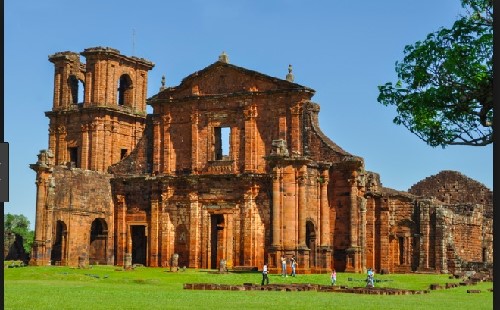
The ruins commemorate colonialism, being a relic of the Jesuits of the Society of Jesus and their evangelizing mission in the 17th century of the indigenous people in the North of Bacia do Rio Prata. As such, the site could become a site of criticism and contestation, but what has happened is that the contemporary local Mbyia-Guarani people have begun to cherish the marks that their ancestors left on the stones of the church that they worked so hard to build. Suddenly, Sao Miguel das Missoes re-emerges as a proud edifice of the former colonized, giving voice and material existence to the contemporary Mbyia-Guarani people, allowing pluriverse epistemologies (Mignolo 2009, 2017) to emerge and re-enforcing local pride in craftmanship and endurance as part of history-making all along. Re-emergence also appears as the church, through the reclaiming gesture of the local descendants of the labour force building the church is reconfigured as entangled materiality between cultures.
(Re)emergence and assemblage
The term emergence draws on materialist and new feminist materialist philosophy and from sociology. ANT, for instance, proposes that society constantly emerges according to the actions and constellations of actors and environments at a certain time and place in history. On close examination, every performative action enacts society. On those lines, sociologist Boaventura de Sousa Santos has offered us a sociology of emergence that can be useful when dealing with re-emergences of colonial heritage futures. Challenging a Eurocentric modernity narrative that does not take into consideration its own foundation on the exploitation of non-European territories, new Epistemologies of the South offer alternative modes of being in, seeing and sensing the world. Sousa Santos is not primarily arguing for an essentialized Southern perspective but is pointing more to how such modes could indicate the re-emergence of a critical utopia itself (2017). He is interested in intercultural communication and introduces the concept of dia-topical hermeneutics (2011) to say that all cultures are incomplete and become enriched by dialogues and encounters with other cultures. Yet another aspect of a sociology of emergence is evoked through the emphasis on affects and emotions in generating new knowledge and practices and in channelling effects such as enthusiasm and anger into collective actions of social change (2003). Re-emergence as a decolonial heritage practice could, from this perspective, open up new forms of collaboration, dialogues and connective actions in the ‘one’ world we all inhabit.
Working with emergence and re-emergence requires a network or assemblage approach to the phenomena under scrutiny. Assemblage theory (DeLanda 2006) evolves around the relationship between a whole and its component parts. Thus, an assemblage approach to colonial heritage in cities would pay attention to at least three entries of emergence that could open and change an entity. One should look at the capacity to interact with other entities, at processes of de-territorialization meaning processes that destabilize spatial boundaries, thus increasing internal heterogeneity, and at processes of decoding that give rise to individual actors or collectives to express convictions and personal styles in relation to the colonial heritage under scrutiny (Ill. 2).
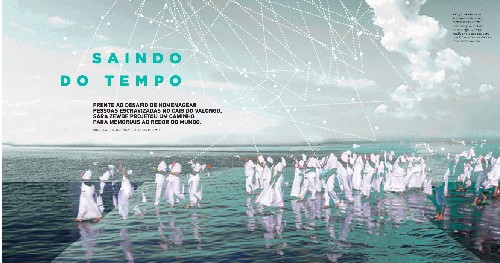
Materialist philosophy and new feminist materialist philosophy give us two important insights that we can use in order to build up the concept of re-emergence in the colonial heritage field. First of all, by stressing the atmospheric liveliness and agency of non-human actors such as monuments, natural landscapes and buildings, the focus is on what these non-human actors are capable of. Do they, as relics of the colonial past, force us into certain ‘sad’ encounters or do they attract us charismatically and seduce us into enthusiastic jerks of a new political life? Giving agency to vibrant matters, as Jane Bennett calls it, and to look at the impacts on concrete audiences is what an analytical framework on re-emergence should practice.
Two pitfalls of binary thinking are present here. Emergence without ‘re’ would be to opt for either de-Westernized or re-Westernized modes of decolonial futures. It would be to believe in a ‘pure’ modernity of progress in new Eurocentric disguise with the oblivion and repression of the colonial history as natural outcomes. Emergence and an inherent repression of coloniality also lie in the de-Westernized alternatives that societies which dispute the control of the colonial matrix of power offer (e.g. China, Russia, Iran). ‘Re’ without emergence, however, entails a nostalgic version of a utopian past – either an idyllic pre-colonial past in a (formerly) colonized country or a romanticized version of colonial rule for the colonizers. Even if neither of them has ever existed, they are nonetheless taken as models of ideal futures in contemporary politics (Boym 2001, Mignolo 2017).
Let us take a recent example of re-emergence in the sphere of decolonial art. On 31 March 2018, in the aftermaths of the centennial commemoration of the sale of the Virgin Islands in 1917 to the US, a monumental sculpture entitled I AM QUEEN MARY was revealed at the Danish West Indian Warehouse (actually hosting the Royal Cast collection of copies) in Copenhagen as a colonial power and those who fought against it (Ill.3).
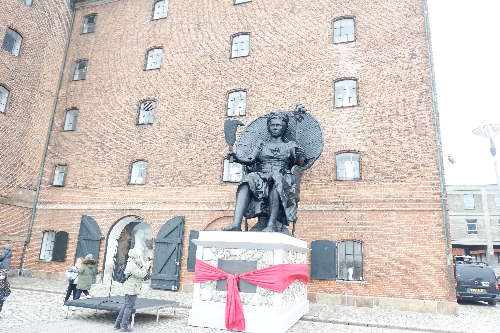
The plinth of the statue is made of coral stones cut from the ocean around the US Virgin Islands by enslaved Africans, and these were originally used to form the foundations of most of the colonial era buildings on the islands. The figurative side of the sculpture is a merging of the historical figure of Mary Thomas, an important leader of the Fireburn labour revolt on St Croix in 1878, and an uprising against contractual servitude 30 years after the abolition of slavery. The peacock chair is a direct reference to Huey P. Newton, leader of the Black Panther Party. The face and body of QUEEN MARY emerge and re-emerge due to scanning technology as a hybrid between Mary Thomas and two artists, Virgin Islander La Vaugh Belle and Danish/ Caribbean Jeannette Ehlers. An excellent example of an activist curatorial-artistic practice that re-politicizes the colonial in an entangled mode (Ill. 4).
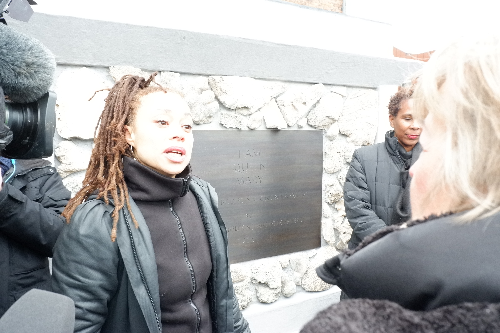
This piece of decolonial heritage is introduced into a setting ripe of repressed colonial relics and references: right onto the waterfront and in front of the West Indian Warehouse through which the triangular trade circulated, with the colonial cast collection as the all-white background against which the colossus of black QUEEN MARY appears. I AM QUEEN MARY is all the more interesting because of its spatial capacities interacting with and altering the urban fabric at this exact spot. Due to the corals in the plinth, the placement in the seaway and the intercultural encounters in and between the artists, I AM QUEEN MARY can be regarded as a powerful de-territorializing force destabilizing the internal homogeneity of an expanded Danish nationhood, of Copenhagen joining a community of former colonizers (finally) commemorating colonialism. It introduces an intercultural communal multi-vocal artistic work as a politically appropriate answer to colonial heritage issues. The sculpture can be remarkably decoded when it comes to its representational layers. Here, multiple sources are at play, they merge, emerge and re-emerge, at one and the same time, representing all of them and none of them entirely, with the past-future axis blown apart, and with a hopeful modesty, depicting the not yet of a more inclusive future (Ill. 5).
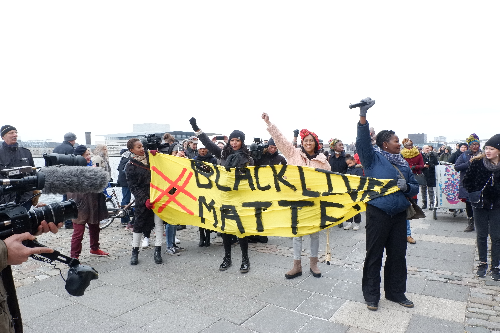
Re-emergence and spectrality
Three kinds of re-emergence can be located in semiotician and literary theorist Walter Mignolo’s thoughts on decolonial futures. Subjects re-emerge as they gain visibility and voice through joining global coalitions of citizen-activists. In these empowered global publics, the sense experience of the racialized subject’s socio-genesis (Fanon 1967) is replaced by the emergence of a more empowered subject of collective and connective action. Historical re-emergence of political hope from the years 1955–61 colours actual political and economic hope of a third way of moving societies forward, a way that is neither capitalist nor communist. The re-emergence of political hope happens from below the state level and comes out of thousands and thousands of decolonial communal projects. Aesthetics re-emerges as artisanal productions fuelled by memories, skills and knowledge that were there before European education intervened, and before creation and creativity became entirely trapped in categories of folklore and religious-mythological beliefs, and these are acknowledged as aesthetic artefacts in their own right.
Re-emergence calls spectres into being. Philosopher Jacques Derrida calls hauntology the emergent re-emergence of haunting pasts. In a usual deconstructivist gesture, spectres trespass on the acknowledged ontological differences between the living and the dead, absence and presence, and break a past-present-future linearity. The spectre is at one and the same time appearing in the present, stemming from the past and opening up the future as the not yet acclaimed by Boaventura de Sousa Santos. A true recognition of the haunting spirits and materialities would reconfigure the course of history and of politics because spectres always appear in times of crisis. The impressive number of contemporary television series showcasing ghosts in various forms, Les Revenants/ The Returned (2012), The Leftovers (2014), River (2015), Le Chalet/ The Chalet (2016), 13 reasons Why (2017), tells us that it has become a theme in popular culture to evoke awareness of unresolved and difficult pasts. The sole presence of the undead is a sign of not having dealt with past deeds. And, in consequence of this, spectres call for a shared sense of responsibility for the injury done. Ghosts and spectres are not supposed to be put to rest, rather we need to learn to live with them and even to be enchanted by their spirits.
Spectres have strong agency: they scare, they attract, they evoke compassion and pity in their status as living dead not capable of dying, they are felt as an unruly mood and atmosphere (Cho 2006). Their agency is made up of different materializations that the ghosts require as new versions of old wounds. It is noteworthy that the reaction towards a spectre is not the same as that towards a traumatic wound. Trauma paralyzes and produces testimonies and witnessing procedures, while haunting is distinctive for producing a something-to-be-done, evoking action, even activism (Gordon 1997). Being haunted is precisely, for Gordon, being drawn affectively, sometimes against one’s will and always a bit magically. Spectres draw us into structures of feeling of a reality we come to experience, not as cold knowledge but as an offer of a hot transformative recognition.
In conclusion, re-emergence primarily happens through two procedures: 1) through the creation of old/ new assemblages having the capacity to open up pluriverse epistemologies, entangled materialities and communal efforts that avoid the trap of identity politics; 2) through hauntings/ spectrality – staged or just unveiled – that give rise to activism and responsibility often afforded by affects, moods and atmospheres.
References:
Bennett, J. (2010). Vibrant Matter. A Political Ecology of Things. London: Duke University Press.
Boym, S. (2001). The Future of Nostalgia. New York: Basic Books.
Cho, G.M. (2008). Haunting the Korean Diaspora. Shame, Secrecy and the Forgotten War. Minneapolis, London: University of Minnesota Press.
DeLanda, M. (2006). A New Philosophy of Society: Assemblage Theory and Social Complexity. London: Continuum.
Derrida, J. (1993) Spectres de Marx. L’Etat de la dette, le travail du deuil et la nouvelle Internationale. Paris: Galilée.
Fanon, F. (1967), [1952]. Black Skin, White Masks. London: Pluto Press.
Gordon, A. F. (2008). Ghostly Matters. Haunting and the Sociological Imagination. Minneapolis, London: University of Minnesota Press.
Mignolo, W. (2014). Interview with Rubén Gaztambide-Fernández in Decolonization: Indigeneity, Education & Society, vol. 3, no. 1, 196–212.
Mignolo, W.D. (2009) ‘Epistemic Disobedience, Independent Thought and De-Colonial Freedom’, Theory,
Culture and Society, 26(7–8), 1–23.
Mignolo, W.D. (2017). Interview with Walter Mignolo: Activism, Trajectory and Key Concepts. CriticalLegal Thinking. 23. January 2017. Accessed online 25 September 2017.
Sousa Santos, B. de (2003) ‘The World Social Forum: Toward a Counter-Hegemonic Globalisation (Part I)’. Critical Engagement. Edited version of part of a paper presented at the XXIV International Congress of the Latin American Studies Association, Dallas, USA, March 27–29, 2003. Accessed online 30 May 2018: 235–45.
Britta Timm Knudsen is Associate Professor at the School of Communication and Culture, Aarhus University, Denmark.
To cite this text:
Knudsen, Britta Timm (2018), ‘Re-emergence’ – as a Mode of practising and managing colonial heritage. [online] ECHOES: European Colonial Heritage Modalities in Entangled Cities. Available at: http://projectechoes.eu/keywords/ [Accessed XX.XX.XXXX].
